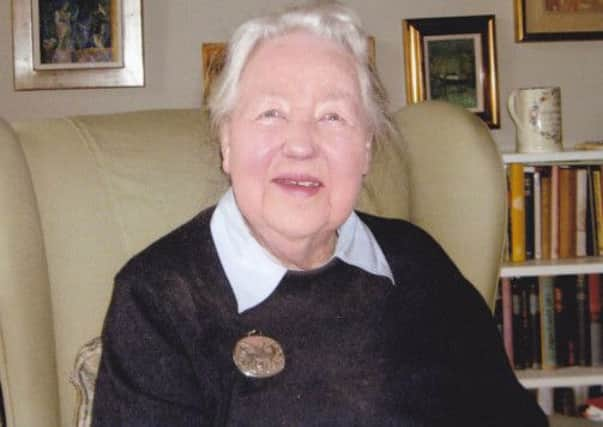Obituary: Hilary McCallum, art teacher and pioneer


Hilary Margaret Campbell McCallum, art teacher and lover of the arts.
Born: 17 January, 1922, in Edinburgh.
Died: 7 December, 2014, in Edinburgh, aged 92.
Inspired by the vision of George Wright Hall, Superintendent of Art to the City of Edinburgh Education Committee, they helped and advised class teachers in a new approach which resulted in creative work by children of all abilities.
Advertisement
Hide AdAdvertisement
Hide AdIn 1947, as part of this programme, Hilary designed, and the children under her direction executed, a mural decoration of “happy horses” for a prominent position in the infant hall of Towerbank School, Portobello, which was reported widely in the press.
Unveiling the mural, Stanley Cursiter, director of the National Gallery of Scotland, referred to the great spiritual and intellectual benefit which children derived from the beautiful surroundings created by a mural decoration of this kind.
She later worked closely with Jack Firth, art advisor to Edinburgh Education Department, later Lothian Region, enthusiastically encouraging children’s creativity in ambitious projects. They remained friends until his death.
Born and brought up in Edinburgh, Hilary was educated at Cranley School for Girls and Edinburgh College of Art, where she was awarded a Fellowship. In 1951, she married Keith McCallum, a Scottish Office civil servant who had been a distinguished scholar at Glasgow University and Balliol College. Sadly, his career and their marriage were tragically cut short by his premature death in 1964.
Hilary and Keith had a passion for art, assembling an impressive collection of paintings by Scottish artists, including Sir Robin Philipson, Dame Elizabeth Blackadder, Anne Redpath, Brenda Mark, John Houston, Sir William Gillies, Jack Firth and David McClure.
Hilary delighted in recounting how she acquired a painting, with personal reminiscences of her friendship with the artist.
She recalled with amusement her reply on being offered an ironing board or a painting as a wedding present. When asked how she chose paintings, she replied: “It is like falling in love, it’s something that comes from the heart.”
She continued to collect with enthusiasm throughout her life, her interests extending to ceramics, books and recordings of classical music.
Advertisement
Hide AdAdvertisement
Hide AdShe was a well-known figure in art circles in Edinburgh and for many years a strong supporter of the Scottish Arts Club, which mounted an exhibition of her collection in 1991.
When her failing health forced her to give up her beloved flat of 60 years, where she was surrounded by a cornucopia of paintings, ceramics, books and records, she took her favourite pieces with her to Cluny Lodge Care Home, where she was looked after for the last five years of her life. Many of the remainder of her collection were exhibited at the Scottish Gallery in 2011 prior to being sold.
In addition to her eclectic interests in the arts, she was a skilled and enthusiastic photographer, capturing the countryside in its varying moods and leaving a fine record of the colleges of Oxford and Cambridge, and the churches and cathedrals she delighted in visiting.
Throughout her life, Hilary was a prolific writer of poetry. Her poems from the 1940s were published in the Scots Review and she found great solace in her writing after the loss of her husband.
One of Hilary’s endearing qualities was her desire to share her interests and enthusiasms with others. Discussion of books, ideas and experiences made for intellectually challenging encounters.
One of her friends spoke not only of her “qualities of decency, kindness, and generosity” but also “her rigorous and sometimes fearsome intellect”. When failing sight restricted her activities, she had an immense reservoir of reflection and anecdote to enrich her life and engage her friends.
She retained close ties with several fellow art students and developed a wide circle of friends in the arts world and beyond. She also developed strong relationships with some of the young people who lived for a time beside her, several of whom attended her funeral.
She encouraged them in their careers and joined enthusiastically in furthering their ambitions. In the 1990s a young medical student, Gavin Francis, occupied the flat above Hilary’s. She followed his subsequent medical career and travels throughout the world with great interest and was always delighted to read the many reports she received from him. His book, True North – Travels in Arctic Europe, was one of those she took with her to Cluny Lodge.
Advertisement
Hide AdAdvertisement
Hide AdOne of Hilary’s chief passions was the island of Gigha, which she visited regularly. She was thrilled when the local people bought the island and worked to develop and expand their community. An early and keen supporter of the Isle of Gigha Trust and as a “Friend of Gigha”, she kept in close touch with the islanders and their progress through their regular newsletters. Another of Hilary’s deep interests was politics. She was an avid reader of political biographies and followed political events in newspapers, wireless, radio and television. A lifelong member of the Liberal party and latterly the Liberal Democrats, she kept carefully her Founder Year Membership of the Scottish Social and Liberal Democrats signed by Lord Mackie, Sir Russell Johnson and Dr Dickson Mabon.
She stoutly maintained this interest and, with characteristically strong views on the independence referendum, was determined to cast her vote.
As a child, she spent many happy summers at Carnwath, her father’s ancestral home, and retained her love of the area throughout her life. Her parents were buried there, as was her husband, and she was very clear that she must be buried beside her husband.
On a rare sunny winter’s day last December, her funeral took place in the presence of those she most loved and admired and who represented a lifetime’s capacity for spirited and generous friendship.
MEM